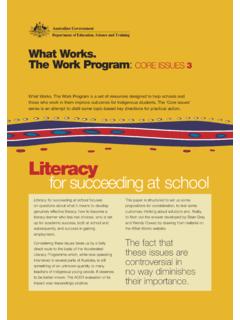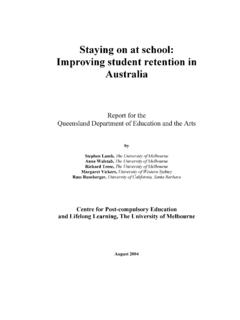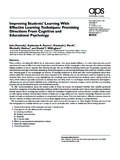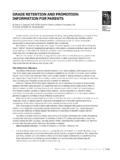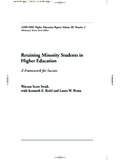Transcription of Student engagement - Improving Outcomes for Indigenous ...
1 What Works. The Work Program: CORE ISSUES5 What Works. The Work Program is a set of resources designed to help schools andthose who work in them improve Outcomes for Indigenous students . The Core issues series is an attempt to distil some topic-based key directions for practical action. Three of these four terms engagement , attendance and participation have ahigh profile in discussions of Improving educational Outcomes for Indigenousstudents. They sometimes have indistinct boundaries with attendance being usedas a synonym for participation for example, and engagement ranging in people sminds from meaning concentrated effort in the classroom to a description of verybroad types of involvement. At ground level, participation probably means thingslike joining in a sports carnival or providing an item at a concert, whereas from atechnical perspective it is often related to grade retention and suspension brings a different flavour to the discussion and is included here forreasons explained overleaf.
2 But taken together they provide a description of howwe want our students to be immersed constructively and enthusiastically in thedevelopmental experiences and products that schooling engagement :Attendance, participation and belongingEngagement is believed to be so significant ithas been used in the most recent MCEETYA paper,Australian Directions in IndigenousEducation 2005 2008, to frame the fivedomains for action ( critical to engagingIndigenous children and young people inlearning ): early childhood education; schooland community educational partnerships;school leadership; quality teaching; andpathways to training, employment and further reason? engagement in learning is critical to academic achievement andproviding students with the understandings,knowledge, skills and confidence to move on into training, employment and highereducation.
3 engagement is critical because it makes a difference to academicachievement and fosters in students a sense of belonging and self-worth. In addition, engaged learners are doers and decision-makers who develop skills in learning,participation and communication that will accompany them throughout adulthood. And its definition: engagement is a constructinvolving three dimensions: behavioural(involvement); affective (personal attachmentto others, such as teachers and classmates);and cognitive (application to learning) (2006: 17). engagement in learning is critical : Only part of the storyIndigenous students school attendanceIt is widely assumed that school attendance rates of Indigenous students are lower than those for non- Indigenous students . A major report onattendance,Better Practice in School Attendance: Improving the school attendance of Indigenous students (2000), prepared for DEST by Colin Bourke andothers, collected and analysed the data which wasavailable at that time and concluded that averageabsenteeism for Indigenous students was about twicethe rate for non- Indigenous students .
4 Attendance wasalso one of the major interests of the recent Review ofAboriginal Education(2004) conducted by the NSWAECG and the NSW DET. Data about attendance was specifically collected for this review from acarefully selected sample of 200 schools for a period of a month and the results, appearing in the tablebelow, very closely resemble those of the DEST study.(Source: NSW Review of Aboriginal Education, 2004: 25.)Without wanting to diminish the scale of the issue andits various impacts, focusing on the negative aspects ofthese data can deflect us from understanding somethingthat the data in this table do tell us in an unqualifiedfashion, and that is:the majority of Indigenousyoung people who are enrolled at school attend regularly and 11 12 Year levelAttendance rates for Indigenous and non- Indigenous students from Kindergarten to Year 12 (sample of 200 NSW schools)Non-IndigenousIndigenousAttendan ce rate2 These data suggest that attendance levels during theprimary years are reasonably consistent but, as fornon- Indigenous students , rates decline quite sharplyin the early secondary years.
5 Some commentatorswould note the probable effect of alienation fromschool among early adolescents applying far morewidely than just to Indigenous students . Attendancelevels improve among those Indigenous studentswho remain in the senior years, remembering thatabout 30 percent leave school at the end of Year might suggest that most school effort related to attendance issues should be directed tostudents in the upper primary and early secondaryyears. However, from their analysis of relevantresearch, Mellor and Corrigan (2004) suggest thatabsenteeism frequently begins in the earliest years of schooling and sets a pattern for future years,suggesting that tackling this problem must beginvery early in the child s school life to be DEST study notes the significant problems in the recording and collection of attendance dataand the high levels of uncertainty about detail,especially in the ways individual students is reflected in the form in which these data are most commonly presented.
6 In Barry Barnes analysis and commentary on attendance issues for the NSW Review, he points out that reporting mean average attendance rates masks the situation of individual patterns ofattendance. An attendance rate of 84 percent for ten students in one school could mean, forexample, that each of the ten students was away for 32 days, in which case 84 percent is verydescriptive of the attendance patterns of thosestudents. Or it could be that two students were away for 160 days each while the remaining eight students attended every single day (2004: 14) in which case the modal average,the most common pattern, would be closer to 100 percent observation is given more concrete substanceby the information presented in the following tabledrawn from the DEST study.
7 Those Indigenousstudents who are not attending regularly havecomparatively longer periods of absence, especiallyin the secondary years.(Source: Bourke et al., 2000: 14.)The DEST study also notes the following. Research reviewed for the project suggests that the level of school attendance in remote/very remote areas is markedly lower than inurban areas, particularly at secondary level;with considerable variation in attendancereported between remote schools, as well asdramatic variation in the level of attendance from one week or time period to another. While the majority of Indigenous studentsmaintain a consistent enrolment in one school,others show very irregular patterns of attendanceand a significant group move frequently betweenschools. Mobility is, in fact, reported to be amajor cause of non-attendance and to haveserious consequences in relation to educationaloutcomes.
8 Indigenous students not only movefrom one school to another more frequently than non- Indigenous students but, in tradition-oriented remote communities, family mobilityassociated with social and cultural obligations,which often entails lengthy Student absencesfrom school (ibid.: 13).It has been commonplace to assume that academicperformance is closely linked to levels of our own discussion of attendance in the WhatWorks Guidebookfor example, it states: There is a very strong correlation between students achievement and attendance levels .After a close investigation of salient research and through his own work, Barnes contests thisnotion, at least in the bland way in which it is stated in the Guidebook. Studies of this issue consistentlyproduce some cases where comparatively poorattenders achieve well academically, and some very consistent attenders do not perform so 10 Indigenous studentsNon- Indigenous 3030+Interval of days absentExperienced teachers could imagine reasons whyboth these situations might occur.
9 Barnes does,however, establish a stronger correlation betweenlevels of attendance and state-wide Year 7 literacyand numeracy test results. He concludes that: Theassociation between attendance and performance isweak for primary education but is strong for earlysecondary education (op. cit.: 22). It would becommon sense to assume that as the work getsharder more consistent and engaged classroomattendance is required for success. More powerfully,it is obvious from looking at the data presented here that at the very point where we can confirm the relationship between academic success andattendance, attendance begins to decline for absenceWhy can attendance be problematic for someIndigenous students ? Barnes provides a schema (op. cit.: 7) which he labels, A multitude of factorsrepeatedly described as impacting on attendance.
10 Every one of these issues, most frequently in concertwith others, could be the reasons for absence fromschool. The What Works Workbookcontains a briefsummary of reasons located for non-attendance in a substantial research investigation (pp. 40 41).Their diversity is enormous boredom,transience, consistent failure, other morepressing responsibilities, peer influence,bullying, being too cool for school .The message is, if you re going towork on attendance issues Find out what is really goingon. Don t make skilled and knowledgablehelp (often available fromyour Indigenous educationworker). Don t take anaggressive stance, withpunishment as the first resort. Think about what the problem really there is a more importantmessage, suggested by the last point of poor attendance as a visible symptomof a situation that needs tackling from a largerand more holistic does not mean don t follow up absences with parents or carers.



